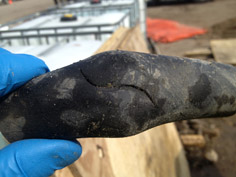Latest News
Considerations for Installing Geothermal HVAC Systems

By Lucas Evenson, Braun Intertec
Ground source or “Geothermal” HVAC systems have been designed and installed readily in our region for more than 30 years.
Savvy building owners understand that while the initial installation cost of geothermal systems will likely be higher than traditional systems, the necessary mechanical equipment boasts lower life cycle costs along with the reduction in operating costs. It can also provide tens of thousands of dollars in savings every year they retain ownership of the building.
However, despite these benefits, the addition of the ground heat exchanger (GHX) needed for these systems to extract and reject heat from the building does add a unique set of risks to a project. If not dealt with properly, it can result in headaches during construction and possibly throughout the life of the building.
Design Related Issues
The two most relevant factors when it comes to GHX design are:
- Evaluation of the heating and cooling loads for the building.
- Appropriate sizing of the GHX based on the calculated loads and site geology.
If heating or cooling loads are underestimated, it can be very difficult to properly size a GHX. The typical trademark of an improperly sized GHX is the entering water temperatures are either too warm or too cold, which will cause decreased equipment performance and even equipment shutdown due to high/low pressure. It should be noted that current design software and practices incorporate a healthy amount of safety and, if anything, most systems are initially over-designed. However, as a building’s heating and cooling requirements change over the years, the same poor equipment performance can be observed. (Photo above: Cracked pipe resulting in loss of system pressure.)
Construction Related Issues
A ground heat exchanger should be looked at like any other component in a building’s mechanical system. The quality of its construction is critical to its performance. In fact, the quality of its construction and preparation should be held to a higher standard due to the fact that it gets buried underneath a parking lot or expensive landscaping features that will result in difficult and costly repair.
A poorly prepared or constructed GHX can present itself in many forms, most commonly but not excluded to: excessively high or low entering water temperatures due to air trapped in the system caused by inadequate purging flow rates; plugged strainers on interior equipment due to debris in the heat transfer fluid (HTF), which is a result of improper flushing; and loss of piping pressure due to a leak in the ground heat exchanger, which is a result of poor fusion quality as well as a lack of proper piping integrity testing. All of the above can be apparent from day one of building operation or can develop over time, even years after the building has been commissioned.
Heat Transfer Fluid (HTF) Related Issues
A ground source HVAC system’s lifeblood is the HTF that continuously flows from the ground heat exchanger to the interior equipment and back again, absorbing then rejecting heat as needed, day in and day out for as long as the building is in operation. In our region, HTF is typically a mixture of propylene glycol (PG), de-ionized water, and corrosion inhibitors. The concentration of these three items plays a key role in the longevity and performance of the geothermal piping system.
For example, the formula used by engineers to calculate turbulent flow (which is necessary for maximum heat transfer in a GHX) is directly affected by PG concentration. Any discrepancy from what is calculated can result in inadequate flow and thus poor heat transfer, which may prevent the mechanical equipment from meeting the heating and cooling needs of the building. Additionally, lack of proper inhibitor levels and use of anything other than de-ionized water are known to cause pipe scaling and degradation, precipitate formation, pump seal failure, and even equipment malfunction.
To summarize, if the system HTF is not properly specified, installed, or mixed, major issues can develop that can cripple the mechanical system’s ability to heat and cool the building. Potentially, this could result in significant down time and costly repairs.
The occurrence of the above described issues can be minimized, if not completely avoided, with proper design techniques, thorough site characterization, specification of GHX commissioning, and meticulous construction processes. As with any construction project, hiring a consultant with relevant experience is crucial and incorporating the geothermal discussion early in the design process will help frame the project for success. It also allows the GHX to provide the building owner with the high performance comfort and low operating costs they expect.
Lucas Evenson, Business Development, Braun Intertec. Phone: (952) 995-2414. Email:levenson@braunintertec.com.
What's New
-

Young Professionals Spotlight
March 25, 2024
-

APWA-MN Education Programs
March 25, 2024
-
Apply for the Young Professionals Stipend: Attend PWX Atlanta
February 23, 2024



